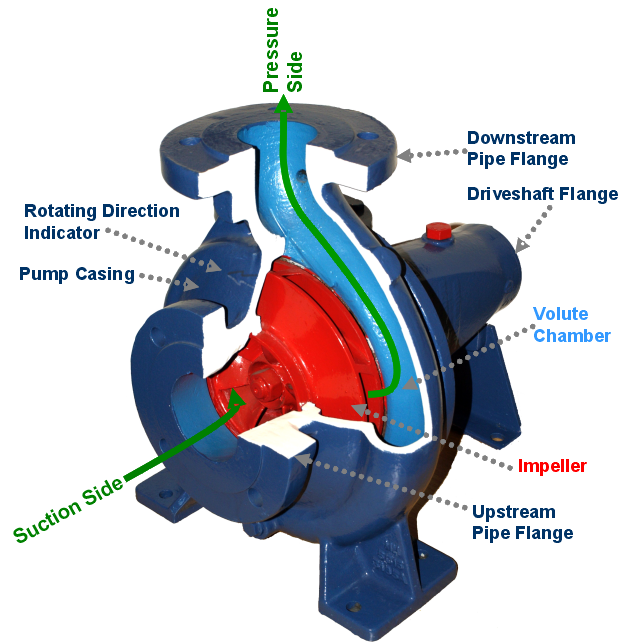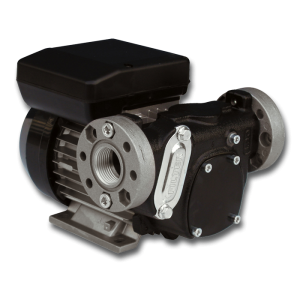The rotary vane pump is a famous diesel transfer pump. It is a positive displacement type pump. It composed of vanes attached to a rotor which revolves within the cavity. In some pumps, the length of these vanes may vary in length (or tensioned) to keep the contact with the edges when the pump revolves. Charles C. Barnes invented this rotary vane pump and registered the patent for this pump on 16th July of 1874. Nowadays, these pumps are widely used in fuel transfer purpose especially for diesel.
Types of rotary vane pumps:
The simple type of rotary vane pump contains a circular rotor which revolves within the large circular chamber. In this pump, the two circles don’t have same line of axis which results in eccentricity. The vanes slide in and out of the rotor and fill up all the edges. This momentum creates the chamber which performs the pumping job. In the intake side, the inlet pressure fills the fluid in to the variable volume vane chambers. The inlet pressure is just the atmospheric pressure which forces the fluid when the system pumps out the air in the chambers. In the discharge side, the fluid is forced out of the pump from the vane chambers. Vane chamber displaces the same amount of fluid in every rotation. Another type of rotary vane pumps is multi stage pump which can work in very low pressures (10 – 3 mbar).
Common Uses of rotary vane pumps:
Rotary vane pump is a very good oil pump. This pump is commonly used as high pressure hydraulic pump. It is also used for automotive purposes like power steering, automatic transmission pumps and supercharging. This pump is used in espresso coffee machines and fountain soft drink dispensers (as carbonator) with low/medium pressures. Large trucks and diesel engine cars (which can’t produce the intake vacuum) are using this pump as vacuum pump for brake assistance through a braking booster. Most light aircrafts are using this pump to drive latitude indicator, gyroscopic flight instruments and heading indicators.
The rotary vane pumps have variety of applications in many industries like secondary gas injection for emission control in auto exhausts (low pressure system), freeze dryers in laboratories, evacuating refrigerant lines in air conditioner (vacuum system), diesel transfer in oil industry, tool for vacuum experiments in physics departments and widely used in semiconductor chemical vapor deposition systems (low pressure system). When the mixture of gas and liquid used in this pump system, they have to be separated externally. To overcome this, the size of inlet and outlet chamber is increased so that the oil will be separated in the large chamber due to gravity. The inlet chamber is cooled (normally the pump is hot) to condense the fluid in the mixture which aids the separation process.
The major advantage of using rotary vane pump is that the system can modify its design to become the variable displacement pump. This makes the pump superior than the fixed displacement pumps in some specific applications. The pump’s displacement is decided by the center line distance which is the distance between eccentric ring and rotor. In vane pump, the pump displacement can be changed by allowing the eccentric ring freely to pivot about rotor. The pump has the ability to pump in reverse, if eccentric ring shifts far enough. But, the performance of the pump can’t be optimized to work in both ways.
Specialty of rotary vane pumps:
The rotary vane umps has the ability to handle viscous fluids, especially they handle low viscous fluids very well (example: LPG, solvents, alcohol, fuel and refrigerants). They have the ability to compensate the need of wear through vane extension which makes them to attain high performance while handling non lubrication fluids. Even though the efficiency of the pump drops immediately, they can handle nearly 500 CPS.
These Vane pumps are available in various configurations such as rolling vane, sliding vane, swinging vane, external vane and flexible vane. These pumps are preferred for their good features like less maintenance, suction power and dry priming. Additionally, they can handle wide range of temperatures from -32°C to 260°C (-25°F – 500°F) and pressures up to 15 BAR/ 200 PSI. The advantages of pumps vary with each type of vane pump. For example, sliding vane pump runs dry for short period, external vane handles large solids…etc.
Working principle:
Though there are many types of vane pumps available, the working principle behind the pumps are same only. The rotor is held up eccentrically in the cyclodial cam. The cavity with crescent shape is created as the rotor is fitted near the wall of cam. Two side plates used to seal the rotor. The vanes are fixed in the slots of the rotor. When the rotor revolves the fluid comes into the pump and the centrifugal and hydraulic pressure push the vanes to the edges. The strength of the seal is the main key for the powerful suction capabilities.
The fluid is pushed into pumping chamber via the holes in the cam. Fluid enters into the space which is created by rotor, vanes and the edges. As the pump revolves, the vanes push the fluid into the other side of crescent. Here, the fluid is forced via discharge holes as the vane completes the rotation. Finally, the fluid exits the pump.
Advantages:
- It is a very good diesel transfer pump.
- It is suitable for vacuum pump as it develops good vacuum.
- Suitable to manage thin liquids at relatively higher pressures.
- Suitable for solvents and LPG.
- It will run dry for shorter periods without any damage.
- It will compensate the need of wear through vane extension.
Disadvantages:
- Complex instrumentation system.
- It can’t handle high pressures.
- It is not suitable for high viscous fluids.
- Not suitable to work with abrasives fluids
- May require two seal/ stuffing boxes
Commercial applications:
- Widely used oil pump.
- Used for bulk transfer of NH3 and LPG.
- Used for filling LPG in cylinders.
- Used deicing and fuel transfer in aviation service.
- Used to handle propellants and aerosol.
- Used in auto industry to handle lubricants, refrigeration coolants and fuels.
- Used to handle freon and ammonia in refrigeration process.
- Widely used for many solvents and aqueous solutions.



